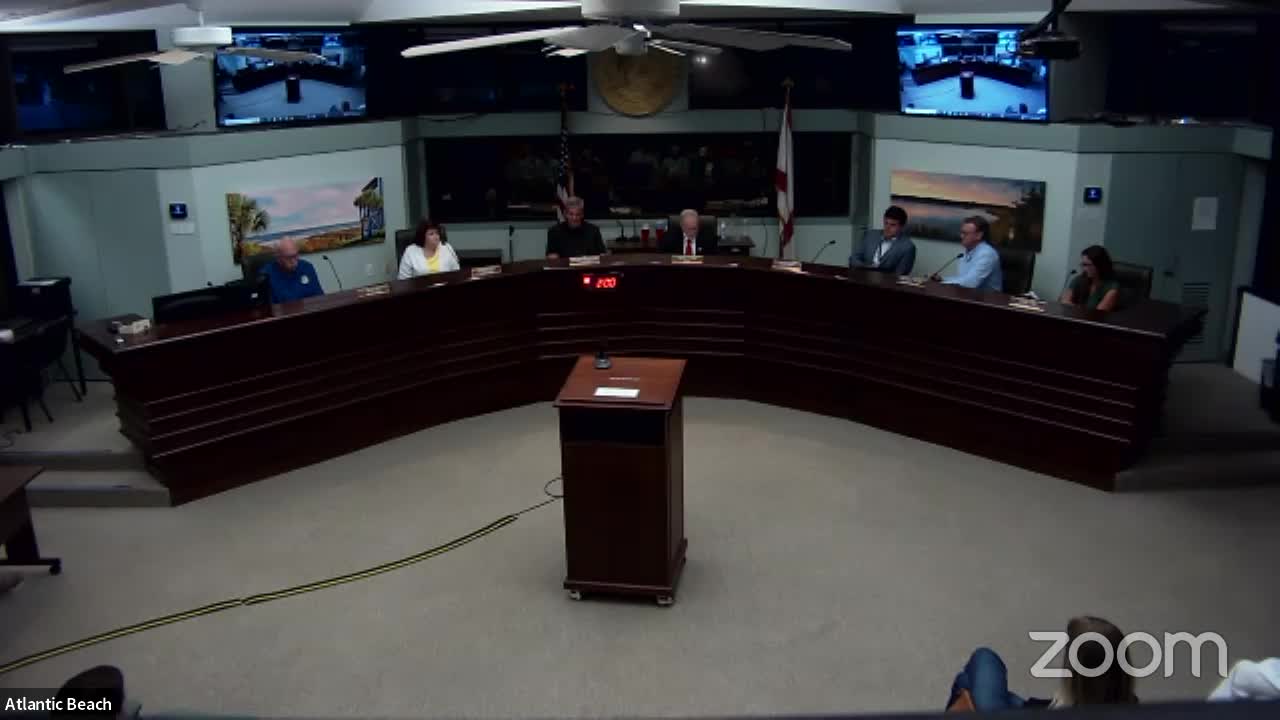Community Divided Over Controversial Townhome Variance Appeal
July 08, 2024 | City of Atlantic Beach, Duval County, Florida

This article was created by AI summarizing key points discussed. AI makes mistakes, so for full details and context, please refer to the video of the full meeting. Please report any errors so we can fix them. Report an error »

In a recent public hearing, the Atlantic Beach City Commission addressed an appeal concerning a variance request for a property located at 1743 Seminole Road. The appeal was initiated after the Community Development Board (CDB) denied a request to reduce the minimum side yard setback on the south side of the property, which is necessary for the construction of a two-story addition.
The variance request aims to allow a 0-foot setback on the shared property line, which has raised concerns among neighboring residents regarding potential impacts on privacy, sunlight, and neighborhood aesthetics. The CDB had previously voted 5-2 against the variance, stating that the request did not meet the criteria outlined in the city’s land development code.
During the hearing, Amanda Askew, the director of planning, provided an overview of the case, emphasizing that the appeal is considered de novo, meaning the commission can review the matter independently of the CDB's prior decision. She noted that the property is zoned for residential use and that the existing townhome was built in 1975, with the proposed addition extending approximately 22 feet in front of the adjacent townhomes.
The applicant's representative argued that the existing zoning code does not adequately address the unique nature of townhomes, which are inherently connected structures. They contended that the addition would not significantly alter the character of the neighborhood and that similar variances had been granted for rear additions in the past.
However, several residents voiced their opposition during the public comment period, expressing concerns that the proposed addition would create a wall-like structure adjacent to their front doors, negatively affecting their living conditions and property values. They highlighted the shared nature of the driveways and parking areas, suggesting that the addition could complicate access and egress for neighboring properties.
The commission is expected to deliberate on the appeal and make a decision that could set a precedent for future variance requests in the area. The outcome will hinge on whether the commission finds sufficient justification for the variance based on the established criteria, which include exceptional circumstances and the potential impact on neighboring properties.
The variance request aims to allow a 0-foot setback on the shared property line, which has raised concerns among neighboring residents regarding potential impacts on privacy, sunlight, and neighborhood aesthetics. The CDB had previously voted 5-2 against the variance, stating that the request did not meet the criteria outlined in the city’s land development code.
During the hearing, Amanda Askew, the director of planning, provided an overview of the case, emphasizing that the appeal is considered de novo, meaning the commission can review the matter independently of the CDB's prior decision. She noted that the property is zoned for residential use and that the existing townhome was built in 1975, with the proposed addition extending approximately 22 feet in front of the adjacent townhomes.
The applicant's representative argued that the existing zoning code does not adequately address the unique nature of townhomes, which are inherently connected structures. They contended that the addition would not significantly alter the character of the neighborhood and that similar variances had been granted for rear additions in the past.
However, several residents voiced their opposition during the public comment period, expressing concerns that the proposed addition would create a wall-like structure adjacent to their front doors, negatively affecting their living conditions and property values. They highlighted the shared nature of the driveways and parking areas, suggesting that the addition could complicate access and egress for neighboring properties.
The commission is expected to deliberate on the appeal and make a decision that could set a precedent for future variance requests in the area. The outcome will hinge on whether the commission finds sufficient justification for the variance based on the established criteria, which include exceptional circumstances and the potential impact on neighboring properties.
View full meeting
This article is based on a recent meeting—watch the full video and explore the complete transcript for deeper insights into the discussion.
View full meeting